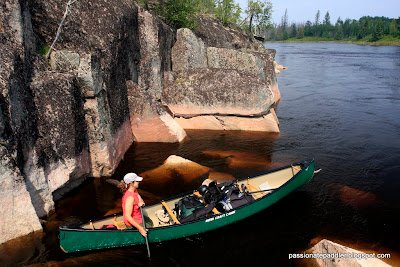
Since when do Aspen grow in water?!! Problem is that
they don't! See the ones angling over?
Timmmmmber!
Ontario this past winter has had record low snowfall. Combine that with record high spring temperatures and little rain meant only one thing for our rivers - very low water levels. This was detrimental to my planned canoe trips this year as 2 major river trips were cancelled due to this. So when the the date for the Bloodvein River trip approached I was cautiously optimistic, especially as there also was an out of control fire burning just 100 kms east of where we were to start! The odds did not look good.
Anxious, a month before the trip I finally decided to check the government website that provides info on current water levels. To my surprise the water levels were actually very high. In fact for the week that water levels were displayed on the graph, it was higher than the maximum values and slowly on its way down! Who would have ever thought!? Relieved, I was now pretty certain that by the time we would be on the river the water levels would still be paddleable. Phew!
on the rock face. This was evident everywhere
in varying levels.
Fast forward into the trip and we started to realize something was 'up'? At first we thought waters levels were normal as we clearly saw a distinct high water level mark. (There was clean pink granite rock approx 2-3 feet below a clear line of thick brown lichen.) Even after our second portage, our first being a short carry down to the lake from the parking lot, we immediately got our feet wet on the trail and assumed just that - a wet portage. However, when almost every portage had pools of water, mud holes, and even 'mini creeks' running through them, we knew this area wasn't experiencing any of the dry conditions further south.
were incredible! Lisa contemplating where
we would end up if we dumped!!
The most obviously evidence of high water levels was at the rapids. Nothing that the guidebook or information we had made sense. It seemed all of the rapids went up a notch or two in classification, with some rapids disappearing all together and even new ones being formed! The most anxious moments were when we were trying to land the canoe at the start of the portage. As most were just at the brink of the foaming whitewater, chute or falls, the unmistakable roar combined with the strong pull of the current meant paddling to the take-out was a nerve-racking affair. We thus started to search and even use high water take-outs when they were available. Occasionally even the put-ins were too risky as well, which inevitably meant portaging further, but given the option it was well worth it.
the boat! (I assumed there wasn't anyone in it!)
Photo: Lisa Riverin-Thomas
All of the evidence plus many more was verified one day when we paddled by a cabin with a floatplane. There was a fellow sitting by shore who had just gone swimming so we decided to paddle by and say hello. We not only found out that this is the last remaining leased cabin in Atikaki Provincial Park, but that the water levels were in fact 7-8 feet above normal levels at this time of year! He amusingly pointed out the curved tops of the handles that stuck out beside us, - it was attached to the dock below our canoe!

One of the truly amazing things that the high water levels
created was dynamic hydraulic art forms. We
called this one the Whale Tail.
The high waters levels and conditions related to it made our trip much more interesting than we'd ever expected. Some good, some bad, sometimes frustrating and other times exciting, but regardless, they all make for good stories! I can laugh at it now, but so can you when I get around writing about it!
tPP



3 comments:
Your photos are stunning - thank you so much for these visual wonders!!! Some how... you always make canoe tripping look as magical as it feels.
I know that unlike me, you are lucky enough to actually spend more time canoeing than blogging about it (I hope to change that in the future).
That being said, just thought I'd be the first to mention the trees in your first photo are actually poplars (not birch), likely Trembling Aspen. Not that anyone likely cares (except the poplar trees may be offended at being called birch :-).
I only mention this because Trembling Aspen and the Paper Birch are two of my favourite trees (have birch in my yard).
Thank you PV! You are right. I just saw the white and made a quick assumption. They definitely look like Trembling Aspen. Thanks for noting that. I will update the blog post!
Post a Comment